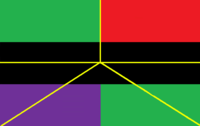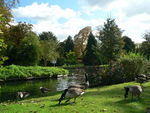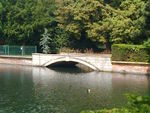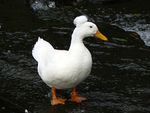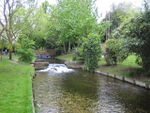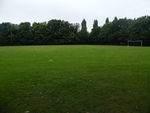Orly
Orly | |
|---|---|
|
Flag | |
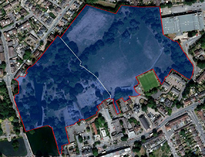 Orly - the Grove to the west, Copan to the east | |
| Official languages | English |
| Demonym(s) | Orlian |
| Government | Absolute monarchy (de jure) Commune (de facto) |
| Jonathan I | |
• King of the Grove | Calum I |
• Queen of Copan | Emma I |
| Establishment | 4 July 2010 |
| Population | |
• Census | ~20 |
| Currency | Pound sterling (£) |
Orly is a nation in the Carshalton Sector which consists of the states of the Kingdom of the Grove and the Kingdom of Copan. Although both states are independent from each other politically, they are collectively known as Orly due to their cultural unity, geographical situation, and joint subordination to the Austenasian Throne. Their monarchies are also linked, with an interregnum in one kingdom causing the monarch of the other to become its temporary regent.
History
The territory held by Orly is also known as the Grove Park. The parkland was in medieval times part of the manor of Stone Court and consisted mainly of meadows. The estate was acquired by John Cater in 1697 and Thomas Scawen in 1729, passing through several hands after Scawen died in 1774. The estate became known as the Grove in the early 1800s and was acquired by a Reverend Cator in 1856 and then by Sir Samuel Barrow in 1895. The estate was bought by Carshalton Urban District Council in 1924 and opened to the public as a park several years later. On 15 March 2004 it was the site of the First Battle of the Grove, in which the Midget Army won a victory over the Girly Gang, and on 2 May 2010 was the site of the Second Battle of the Grove, in which foreign supporters of Emperor Esmond III were victorious over foreign Carolinians in the Austenasian Civil War.
On 4 July 2010, a large group of regular visitors to the park - most of them having been supporters of the Emperor during the Civil War and so inspired by Austenasia - declared independence under Caesar Calum, founding the Caesarship of Orly under Austenasian suzerainty. A few weeks later on 19 July, Calum I split the Caesarship into the Kingdom of the Grove, over which he retained control, and the Kingdom of Copan, the throne of which he gave to King Declan I (the then Crown Prince Jonathan of Austenasia ruled as Viceroy).
The Grove recognised Esmond III of Austenasia as the Western Emperor, with Calum openly respecting Esmond III as his superior. Although the citizens of Copan also recognised the Emperor as preeminent monarch in the Carshalton Sector, Declan I rejected his claim to suzerainty over Copan on 11 September 2010. Esmond III removed Calum I from power over the Grove in November 2010 and replaced him with Lord Regent Jonathan, who abdicated the following month.
With the Grove without a leader, Declan I took the throne as Regent under the terms of the Edict of Orly, which had split the original Caesarship in two. Declan I then declared himself Tsar of a re-unified "Tsardom of Orly" without the consent of Esmond III, who as Emperor had the right to choose a new leader of the Grove under the same edict. When, a day after the reunification, he insisted to be permitted to exercise this prerogative, Declan rejected all claims of Imperial suzerainty over Orly, leading to the War of the Orlian Reunification. Declan won the war, gaining the Throne of Austenasia in the process and making Orly a vassal state of his native state of Wilcsland.
To govern Orly from over seventy miles away, Declan I established a Viceroy to represent him in Orly, with a vassal monarch for the Grove and for Copan to help govern Orly as local deputies of the Viceroy. Efforts were made under the Tsardom to develop the culture of the nation, such as the foundation of the Orlian College of Cardinals. However, said college consisted almost entirely of foreigners, and during this period many of the original citizens of Orly began to socialise elsewhere (such as in Sutton).
On 14 January 2012, the local vassal monarchies were abolished (except the Prince of Copan, which was kept as a ceremonial title) and Declan I declared Orly to be entered into a political union with Wilcsland, as part of the new United Kingdom of New Wessex. The Viceroy, Crown Prince Jonathan, was kept in his position as such. A year later, on 20 January 2013, Declan I abdicated from Austenasia and was succeeded as Emperor by the now Jonathan I, but both monarchs initially retained their positions as King and Viceroy respectively in Orly.
However, on 24 June 2013, Orly became independent from Declan's rule. Declan I planned to visit Orly for the first time, and a group of Orlians gathered to meet him. However, they became disgruntled when they found out they would have to wait for two hours due to him missing his train, and then openly rebellious when they discovered he planned to demand Jonathan I relinquish the title Shahanshah of the Carshalton Nations when he arrives, expressing their wishes for Orly to be under Austenasian suzerainty once more. Declan I was declared deposed (and the visit cancelled), and the Grove and Copan were refounded as independent monarchies, with the Emperor appointing a "native" Orlian monarch to the throne of each. The flag of Wilcsland was removed from the top-left canton of the Orlian and Copanese flags on 18 October 2013 by Jonathan I in recognition of the end of Wessaxon dominance over Orly.
Government and politics
The Grove and Copan both function as absolute monarchies, with the former currently ruled by King Calum I and the latter by Queen Emma I.
Orly and its two states have always been absolute monarchies throughout their histories. At several times during the Tsardom, there two equal monarchs of Orly, with Declan I appointing another Tsar or Tsarina only to later depose them in his capacity as King of Wilcsland, which claimed suzerainty over the Tsardom. As every co-ruler of Wilcsland during the Tsardom's existence was also made a co-monarch of Orly in this way, Orly and Wilcsland were by convention therefore in de facto real union even before entering into the political union as New Wessex.
Although Orly has been under de facto Wilcslandian domination for much of its history (December 2010 - June 2013), for the first five months of its existence and since the Liberation of Orly it has been under Austenasian suzerainty, with the population and monarchs (with the exception of Declan I as King of Copan between September and December 2010) recognising the Emperor of Austenasia as being the source of lawful authority within Orly. Even during Wilcslandian and Wessaxon domination of Orly, for the majority of that time Declan I held the Austenasian Throne and so his rule was acceptable to the Orlian population. The Emperor of Austenasia has the right to appoint a new monarch of either the Grove or Copan should the throne become vacant - in the meantime, the monarch of the other nation becomes temporary regent.
Although the monarchs have in theory absolute authority over the Grove and Copan, in practice they have very little power over domestic affairs. The Orlian population is very similar to a commune - however, the leaders of the nation are acknowledged and their titles respected by the Orlians. The main de facto duties of the two monarchs are to advance culture and to represent their states internationally.
List of monarchs
Caesarship of Orly and 2010 independent Kingdoms
- HIH Caesar Calum, Caesar of Orly: 4 July 2010 - 19 July 2010
- HI&RM King Calum I, King of the Grove: 19 July 2010 - 12 November 2010
- HM King Declan I, King of Copan: 19 July 2010 - 8 December 2010
- HIH Crown Prince Jonathan, Lord Regent of the Grove: 12 November 2010 - 8 December 2010
- HM King Declan I, Regent of the Grove: 8 December 2010
Tsardom of Orly
- HIM Tsar Declan I, Tsar of Orly: 8 December 2010 - 14 January 2012
Co-monarchs:
- HIM Tsarina Frances I, Tsarina of Orly: 8 December 2010 - 15 February 2011
- HIM Tsar Ptolemy I Alexander, Tsar of Orly: 15 February 2011 - 16 February 2011
- HIM Tsarina Berenice I, Tsarina of Orly: 16 February 2011
- HIM Tsarina Arsinoe I Cleopatra, Tsarina of Orly: 16 February 2011 - 21 February 2011
- HIM Tsar Ptolemy II Helios, Tsar of Orly: 21 February 2011 - 12 March 2011
- HIM Tsarina Arsinoe II, Tsarina of Orly: 27 August 2011 - 31 August 2011
Vassal monarchs:
- HM King Calum I, King of the Grove: 13 January 2011 - 14 January 2012
- HSH Prince Miles, Prince of Copan: 8 March 2011 - 24 April 2011
- HSH Prince Joseph, Prince of Copan: 24 April 2011 - 2 August 2011
- HIM Emperor Esmond III/HM King Ptolemy IV, Prince of Copan: 2 August 2011 - 14 January 2012
Orly under New Wessex
- HM King Declan I, King of Orly: 14 January 2012 - 24 June 2013
2013 - present independent Kingdoms
Grove:
- HM King Calum I, King of the Grove: 24 June 2013 – present
Copan:
- HM Queen Emma I, Queen of Copan: 24 June 2013 – present
Geography
This section is empty. You can help by adding to it. (September 2022) |
Gallery
-
The Grove as seen from the other end of the Plain of Copan, 2012.
-
Memphis, capital of Orly and of the Grove, 2011.
-
The Secluded Place, capital of Copan, 2012.
-
The Wandle in the Grove, 2008.
-
Widsom, 2009. The Wisdom Tree can be seen on the lawn to the right.
-
The Upper Mill, 2007.
-
Grove House, 2007.
-
Leoni Bridge from the south-east, 2012.
-
Looking north from the Leoni Bridge, 2012.
-
The site of the 2004 Midgets' Base, 2012.
-
Part of East Bank, 2012.
-
The Cascade in snow, 2007.
-
The Plain of Copan in rain on the day of the Battle of the Grove, 2010.
-
"Afroduck", a famous resident of the Grove, 2010.
-
The Wandle downstream from the Cascade, 2007.
-
The Playing Field, 2012.
-
The Copanese Regnal List, 2012.
-
The entrance to the Secluded Place, 2012.
